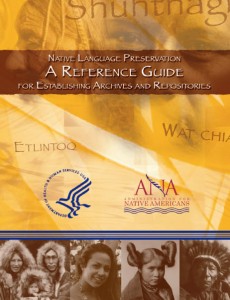Native Language Preservation: A Reference Guide for Establishing Archives and Repositories
During the MET 521 course there has been much discussion around the importance of preserving Native Languages, however very little specific information about how this is done on a practical level has been shared. This PDF guide is a practical reference guide that describes the specific steps and processes to preserve a language. Chapters include:
Chapter 1: Why Preserve Native Heritage Language Materials?
Chapter 2: What to Preserve: A Practical Approach to Preservation
Chapter 3: What Is a Language Repository?
Chapter 4: How to build infrastructure to Preserve Native Language Materials
Chapter 5: Where to Locate Resources in Selected Native Repositories and How to Find Selected Native Language Materials
Chapter 6: Where to Locate Resources in Selected Educational, Federal, and Other Repositories
Note: There are also 11 assorted appendices included.
http://www.aihec.org/resources/documents/NativeLanguagePreservationReferenceGuide.pdf
November 29, 2010 No Comments
UN Report: Indigenous Rights Ignored In Global IP Policy
http://www.ip-watch.org/weblog/2010/01/14/un-report-indigenous-rights-ignored-in-global-ip-policy/
This 2010 web site provides a summary of, and link to, reportedly the first UN publication that attempts to provide an overview of the health, education, income, and access to employment status of the estimated 370 million Indigenous individuals living worldwide. The site also describes Western legal views versus Indigenous views of IP ownership. Of particular relevance to MET 521 is the section describing the discussions around perceived IP ownership being undertaken at the World Intellectual Property Organization (WIPO) on traditional knowledge.
November 29, 2010 No Comments
Protocols for Cultural and Intellectual Property Rights of Iwi
http://maoriart.org.nz/features/articles/protocols_discussion
This web site lists several Protocols for Cultural and Intellectual Property Rights of the Maori Iwi (traditional tribes), based on the Mataatua Declaration of Indigenous Rights. Included are eight recommendations to Iwi, 5 recommendations to states, national and international agencies, and 9 points describing biodiversity and customary environment management property rights.
Note: I was curious about the term Mataatua. Here’s what Wikipedia had listed for it:
Mataatua was one of the great voyaging canoes by which Polynesians migrated to New Zealand. Māori traditions say that the Mataatua was initially sent from Hawaiki to bring supplies of kūmara to Māori settlements in New Zealand. The Mataatua was captained by Toroa, accompanied by his brother, Puhi; his sister, Muriwai; his son, Ruaihona; and daughter, Wairaka.
November 28, 2010 No Comments
Under CAFTA, Indigenous heritage becomes intellectual property for the United States
http://www.cancerplants.com/herbal_traditions.html
Throughout this course, I’ve found discussion around the issue of intellectual property particularly interesting. Living in British Columbia, it would be difficult to miss the ongoing debate around the local fisheries with regard to who owns what, and how far Indigenous people’s rights extend when it comes to rules around harvesting marine resources.
For these reasons, I found the Cancer Plants web page describing foreign ownership of the right to exploit a region’s abundant and diverse tropical flora, very provocative. According to this page, under the intellectual-property provisions of CAFTA, the US has forced legislation in member countries that potentially legalizes patenting the biological resources of the region to the benefit of pharmaceutical and agro-industrial companies. Indigenous communities and environmentalists call these practices biopiracy while international pharmaceutical companies and academic researchers call them bioprospecting. Whatever the term used, the ethical, environmental, and commercial implications of this practice could be enormous.
November 28, 2010 No Comments
The Hans Rausing Endangered Languages Project
The aim of the Hans Rausing Endangered Languages Project (HRELP) is to document endangered languages, train language documenters, preserve and disseminate documentation materials, and support endangered languages.
HRELP is based at SOAS, University of London, and consists of three programmes:
- The Documentation Programme (ELDP) is providing £15 million in research grants to document the world’s most endangered languages.
- The Academic Programme (ELAP) Teaches postgraduate courses in language documentation and description, and field linguistics. It also hosts post-doctoral fellows, researchers, visitors, and conducts seminars and training.
- The Archiving Programme (ELAR) is preserving and disseminating endangered language documentation, developing resources, and conducting training in documentation and archiving.
For more information: http://www.hrelp.org/
November 7, 2010 No Comments

